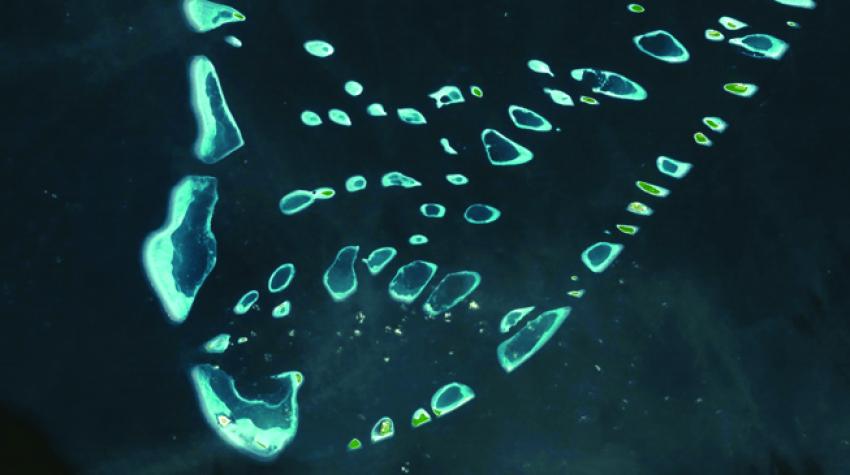May 2017, Nos. 1 & 2 Volume LIV, Our Ocean, Our World
There are few more powerful symbols of the international community's shared past and future than the ocean. From the earliest human migrations, it carried our ancestors to new continents, brought civilizations together, and opened the world to exploration and trade. It also connects us ecologically. Numerous fish species swim across territorial waters to spawn and feed, supporting billion-dollar fisheries and countless livelihoods. Most importantly, the ocean is the central force in regulating the global climate that sustains us all. In fact, scientists have shown that since the onset of the industrial age, the oceans have borne the brunt of consequences from excessive burning of fossil fuels, absorbing carbon dioxide emissions and the majority of the heat generated from global warming.
But even the vast ocean has its limits. All that CO2 has turned it more acidic, effectively dissolving corals and shellfish and profoundly altering critical habitats and marine resources. At the same time, sea surface temperatures are the highest they have been in millions of years, and there is now evidence warming is occurring much deeper than previously anticipated. New research suggests that by acting as a temperature sink, the oceans have prevented catastrophic temperature rise on land.
A 2016 International Union for Conservation of Nature report called soaring ocean temperatures the "greatest hidden challenge of our generation.1 "Hidden" because beneath the waves, warming has affected all marine life, from the smallest microbes to the largest whales, setting the stage for a precipitous collapse and putting "key human sectors [...] at threat, especially fisheries, aquaculture, coastal risk management, health and coastal tourism."2 This threat is particularly acute for small island developing States (SIDS). We are still highly dependent on marine resources for food and income, and need vibrant ocean habitats for our tourism businesses. We are also vulnerable to rising sea levels driven by global warming, which not only threaten our coastal infrastructure, but could also render our islands uninhabitable if left unchecked.
For these reasons, the Maldives and many other SIDS, often known as large ocean States, were some of the strongest proponents of Sustainable Development Goal 14 in the 2030 Agenda. SDG 14 comprises a number of targets designed to "conserve and sustainably use the oceans, seas and marine resources for sustainable development." It also recognizes that meeting these targets will be difficult if not impossible if we do not limit the greenhouse gas emissions that lie behind so many problems.
Indeed, SIDS have also led the world in efforts to implement SDG 14, from our ambitious efforts to cut emissions to sustainable development projects that help us adapt to life in a warming world. Consider SIDS work to establish marine protected areas (MPAs) that benefit millions upon millions of people who depend on healthy marine systems for food and income around the world.
Beginning in 2004, for example, the Maldives worked with the United Nations to establish the Baa Atoll Biosphere Reserve. It was selected because of its remarkable biodiversity and potential to demonstrate the economic benefits of conservation. In just a short period of time, the atolls have shown remarkable resilience against warming waters compared to other habitats.
In the Caribbean, the MPAs of Grenada are living evidence of how protecting essential fish habitat pays long-term benefits by raising the productivity of commercially valuable stocks.
Elsewhere, in the Pacific, Palau, the Marshall Islands, and the Federated States of Micronesia have devoted a significant amount of their waters to MPAs, safeguarding sharks, turtles and critical spawning grounds for countless species. They have also worked tirelessly to call attention to the problem of plastics pollution, which poses a severe threat to marine life and the human communities it sustains on land.
Still, even as we work to protect and restore marine environments, islands have been forced to make large investments to protect our shores from severe climate change impacts such as erosion and rising seas. In the Maldives, we have been forced to climate-proof infrastructure, including wharfs, roads, sea walls and sanitation. These projects are extremely costly and divert resources away from other priorities such as public health and education. Other SIDS have had to reimagine their development futures in the face of the uncertainties that stem from climate change and ocean degradation.
One thing is for sure: just as the impacts of overfishing, pollution and climate change are global, so too are the solutions. Protecting the ocean for present and future generations requires all countries to fulfil the commitments made to support the means of implementation of the 2030 Agenda and cut emissions. Like the ocean, SDG 14 must bring us together again.
Notes
1 Dan Laffoley and John M. Baxter, eds., Explaining Ocean Warming: Causes, Scale, Effects and Consequences (Gland, Switzerland, International Union for Conservation of Nature, 2016), p. 8. Available from: https://portals.iucn.org/library/sites/library/files/documents/2016-046_....
2 Ibid., p. 50.
The UN Chronicle is not an official record. It is privileged to host senior United Nations officials as well as distinguished contributors from outside the United Nations system whose views are not necessarily those of the United Nations. Similarly, the boundaries and names shown, and the designations used, in maps or articles do not necessarily imply endorsement or acceptance by the United Nations.




